 |
  Home | Contact | Site Map |

| Top Destinations |
|
You are here Home » Top Destinations » Rajasthan
Honeymoon in Rajasthan India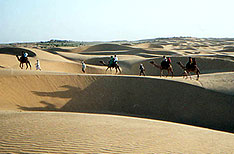 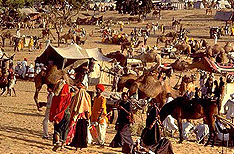 About Rajasthan Rajasthan, the land of kings, the home of the Rajputs- a group of warrior clan, is the magical land set amidst the desolate desert beauty. Though it's former rulers are dead and gone, the forts and palaces of amazing architectural beauty and luxury, still stand testimony to its rich cultural heritage reminding of the romance and chivalry, pride and honour, joy and warmth of hospitality that is unique. The historic cities of Rajasthan also maintain their traditional flavor in their arts and craft, colorful and buzzing marketplaces with vibrant men in turbans and women with bright mirrored skirts and jewelry. The modes of transport reveal a blend of modernity with the plying of camels, oxen, elephants, buses and cars. Lively folk dances and music, ballads and colorful festivities are an integral part of its vital culture. Like all deserts, miles of golden stretches of sand of Thar also offer the tremor of life in its oases of magic and romance. Many beautiful temples and mosques also dot the entire state and they come alive during usual Hindu and muslimfairs and festivals. Some of the finest national parks and sanctuaries are a rich source of pastime, pleasure and excitement for the wildlife enthusiasts. Rajasthan is widely known for its fine miniature paintings, fabulous fabrics and Jewelry and a host of beautiful handicrafts.Travel masti brings to you a variety of travel and tourism activities to choose from in this magnificent land. HISTORYThe past flavor lingers on. However, Rajasthan is much more than the imagination of few rulers. It is an identity created by people, who enjoy life and have ample proof to show for it. The earliest inhabitants of Rajasthan belonged to the Great Harappan Civilization. This area saw the arrival of the horse riding Aryans from central Asia in about 2000 BC. The Mauryan dynasty-one of the first dynasties to rule over large parts of India controlled this area in about 400 AD. With the passing of time however this arid region became the scene of the ravaging onslaught brought about by the Huns and the Scythians. The settling of the Scythians in Rajasthan set the stage for the rise of the Rajputs who were the offspring's of the Indo-Scythians. With the passing of time this new race proliferated into a number of new clans. Rajasthan thus became the homeland of these groups of warrior clans, collectively called Rajputs, who dominated this region for over a thousand years. They carved out small kingdoms in this region during the 9th and 10th century AD that were often at war with each other. Due to this lack of unity, the Rajputs were unable to present a combined front against a common aggressor. This weakness ensured that every foreign aggressor in India created enough trouble for the Rajput rulers of Rajasthan. All this resulted in them being defeated or subjugated by the Mughals, who reduced them to the status of a vassal. Nevertheless the bravery and, sense of pride and honor amongst Rajputs is unparallel in the history of India. Chivalry was the hallmark of the Rajputs. They fought with courage and determination. Death to defeat was the theme of Rajput warring ideology. They would face the enemy with all the might even if defeat were imminent; in which case jauhar was performed. In this grim ritual women and children would commit suicide by immersing themselves in a huge funeral pyre. It was for these qualities that some of the Rajputs rulers and chieftains adorned the court of most of the Mughal rulers especially Akbar. There warring skills were used to the fullest by Akbar who very effectively used the services of these brave fighters for the protection of his vast kingdom by inducting into his standing army. He also entered into matrimonial alliances with prominent Rajput families most important being the one with princess Jodha Bai, daughter of the Maharaja of Amber. With the decline of the Mughal Empire, the Rajputs were gradually able to recover their lost territories and status. These turn of events were however short-lived, as very soon the British set foot on the Indian mainland marking the beginning of one of the most eventful phase of Indian history. The British Raj, as it was popularly called, was characterized by many anew trends and practices. One of these was their policy of signing articles of alliances with most of the princely states in India that ensured their independent existence subject to certain political and economic restrictions. This marked the decline of the once mighty and powerful Rajput dynasties of this region.After independence Rajasthan became an integral part of the Union of India under the new constitution. CULTUREHindi is the official language of the state. But the principal language is "Rajasthani", and the four major dialects are Marwari in the west, Jaipuri in the east, Malwi in the southeast and Mewati in the northeast. But Hindi language is replacing Rajasthani. Moreover, you will find English speaking people in all the major cities, and in remote villages also you will find someone who can speak and understand English. But other languages are completely unknown. You may ask Tour Operators to help you on this and they do have guides who knows almost all the languages. Like the topographical variation of the land, the culture of Rajasthan is a wide spectrum of brilliant hues caressed by waves of settlers ranging from ancient Indus Valley urbanites to pastoral Aryan herdsmen, Bhil forest dwellers, Jain merchant princes, Jat and Gujjar cultivators, Muslim craftsmen, and the Rajput warrior aristocracy. All shaped this region called the land of kings. Colorful costumes, festivals and customs relieve the tedium of coping with a harsh, demanding land. People travel to Rajasthan to savor its splendors and imbibe its enviable heritage. Discover it all in the fairs and festivals, folk music, Rajasthani cuisine and crafts of Rajasthan. FAIRS AND FESTIVALSThe Rajasthani?s love for colour and joyous celebrations is proved by the elaborate rituals and the gay abandon with which he surrenders himself to the numerous fairs and festivals of the region. In addition to the festivals celebrated by the Hindus, Muslims and others, there are also the traditional fairs. There are animal fairs, there are religious fairs and there are fairs to mark the changing seasons. Infact, celebrations occur almost round the year and are a splendid opportunity for the visitor to gain an insight into the life of the Rajasthani. Other than the traditional fairs, recently established festivals which involve elephants, camel races, dance and music have been specially organised for the tourists. Among the better known fairs of Rajasthan are: Nagaur Fair, Nagaur (Jan-Feb.)Essentially an animal fair, it provides an opportunity to participate in some of the local sports. Desert Festival, Jaisalmer (Jan-Feb.)One of the most popular of all festivals it is a journey into the heart of the desert, the golden city of Jaisalmer that has a charm of its own. A true show on the sands which attracts even the much traveled visitor. Baneshwar Fair, Baneshwar (Jan-Feb.)A religious festival with simple and traditional rituals. This fair is the centre of attraction of a large number of tribals from the neighboring states of Madhya Pradesh and Gujarat who join their brethren from Rajasthan in offering prayers to Lord Shiva. Gangaur, Jaipur (March-April)A festival devoted to Goddess Parvati,the consort of Lord Shiva. It is time for young girls to dress up in their finery and pray for grooms of their choice while the married women pray for the well-being of their husbands. This 18-days festival is laced with various activities and culminates in a grand procession marking the arrival of Shiva to escort his bride home. Mewar Festival, Udaipur (March-April)A festival to welcome the spring season. There is song, dance, processions, devotional music and fireworks where almost everybody participates. Elephant Festival, Jaipur (March-April)A festival to celebrate Holi, this is a great occasion for the visitor to watch several elephant sports and also play this festival of colours. A show is organised with the elephants turning out in their best finery. Urs Ajmer Sharif, Ajmer (According to Lunar Calendar)Held in the memory of the revered Sufi Saint Khawaja Moinuddin Chisti, it is an occasion for thousands of believers to congregate at the shrine and offer their prayers. All of Ajmer seems to take on a festive air and several programmes are organised to mark the festivals. Summer Festival, Mt.Abu (June)Organised in the only hill station of Rajasthan, this is the coldest place at this time of the year. Folk dances and a general atmosphere of gaiety prevails in this tiny hill resort and the tourist has ample time to relax and enjoy himself. Teej, Jaipur (July-August)A festival to mark the advent of monsoon. Processions, women dressed in bright colours and a lot of merriment prevails during Teej. Essentially a women?s festival, it is interesting to watch them enjoying in groups and at various bazaars where they turn up to shop in all their finery. Marwar Festival, Jodhpur (October)A festival devoted mainly to the music and dance of the Marwar region. This is a festival that allows the visitor to understand and enjoy the folk traditions of this part of the state. Pushkar Fair, Puskkar (November)The well-known and marked with largest participation of all the festivals of Rajasthan, Pushkar is an important pilgrimage as well as the venue of a mammoth cattle fair. Bazaars, auctions, music and sports are highlight of this event. Camel Festival, Bikaner (January)An enchanting desert city which comes alive with music and dance. It is fast gaining popularity as the visitor finds an opportunity to see some unusual folk performances, camel, race camel dance etc. FOLK DANCESDance is an expression of human emotion as mush as music and it is found in almost limitless variations in Rajasthan. Simple unsophisticated, dancing is seen in their fairs and festivals in the kudakna of the Meena boys, the dancing which goes with the Rasiya songs of Braj, and the dancing by women and men where the women carry a pot or a lighted lamp on their head. In the Charkala dance of Braj, an elaborate lampstand replaces the single lamp. The Gair of Mewar have inner and outer circles of dancers who move diagonally or loop in and out. It is intricate and fascinating. The Gair of Jodhpur is performed in a single file and martial costumes are worn for effect. The Geendad of Shekhawati is similar. Sticks or swords are often used in male dances, and the Shekhawati dance has the daf accompanying it. The terahtali is a tantalising dance performed by women while sitting. The women have manjeeras( little brass discs) tied with long strings to their wrists, elbows, waists, arms and a pair in their hands as well. Their male accompanists sing and play the tandoora while the women, with sextrous and fine movements, create a strong rhythm with the manjeeras. Foe added effect they may hold a sword between their teeth or balance pots or lighted lamps on their heads. The famous Ghoomar, Rajasthan's popular dance gets its name from ghoomna, the pirouetting which displays spectacular colors of the flowing ghagra, the long skirt of the Rajasthani women. Men have a range of their own more vigourous dances. Free dancing full of zest, with rows of dancers waving colorful pennants, makes the Bam rasiya of the Braj region spectecular. It is performed at holi. The Kucchhi Ghodhi or Dummy Horse dance is performed on festive occasions. The dance of the Kalbelia women is vigourous and graceful. An authentic fire dance is performed by the Jasnathis of Bikaner and Churu districts. The accompanying music rises in tempo as the dance progresses, ending with the performer dancing on brightly glowing embers-a breathtaking and deeply impressive sight. The terahtali is a tantalising dance performed by women while sitting. The women have manjeeras( little brass discs) tied with long strings to their wrists, elbows, waists, arms and a pair in their hands as well. Their male accompanists sing and play the tandoora while the women, with sextrous and fine movements, create a strong rhythm with the manjeeras. Foe added effect they may hold a sword between their teeth or balance pots or lighted lamps on their heads. ART AND ARCHITECTURERajasthan is known for its traditional and colorful art. The block prints, tie and die prints, Bagaru prints, Sanganer prints, Zari embroidery are major export products from Rajasthan. Handicraft items like wooden furniture and handicrafts, carpets, blur potteries are some of the things you will find here. Rajasthan is shoppers paradise. Rajasthan is famous for the majestic forts, intricately carved temples and decorated havelis. Jantar Mantar, Dilwara Temples, Chittauragrh Fort, Lake Palace Hotel, City Palaces, Jaisalmer Havelis are true architectural heritage. SHOPPINGRajasthan is among the richest state in the country as far as the fields of arts and crafts is concerned. Rajasthan has created and preserved rich craft heritage which includes fabulous fabrics in lovely prints, precious and semi-precious stones, Kundan Meenakari Jewellery, embroidered leather work, other hand crafted items of wood, ivory, lac, glass, brass, silver and gold. Carpets and DurriesThe hand knotted woolen carpets of Tonk, Bikaner, and Jaipur are generally based on Persian styles. The traditional cotton durries of Jaipur, Jodhpur are mostly in pastle shades with geometrical motifs design. Leather wareLeather is also an essential raw material for making musical instruments such as the tabla, dhol, kamaycha. These instruments are used by Rajasthani folk musicians. The world fame jootis are made from leather having artistically embroidered uppers. These are incredibly comfortable and sturdy. Jaipur, Jodhpur, Barmer and Jaisalmer are traditionally known for these footwear. Bikaner is known for its painted lamp shades, shields and vases made from camel hide .Designer hand-bags, purses, belts, hats, stools and collapsible chairs with graphic embroideries made from leather at Tilonia village near Ajmer is also example of good craft man ship. PaintingsPainting of Rajasthan miniature and folk are known all over the world for treatment and composition, color scheme and subjecting. Use of vibrant colours, bold lines, two dimensional treatment of figures and entire composition distributed in compartments are some of the unique features of these paintings, popularly known as ?phad? paintings. Wall PaintingsPalaces, Havelies, even huts are commonly having Walls and ceilings covered with colorful paintings in Rajasthan. Some of the finest paintings can be seen in havelis of the Shekhawati region and the ancient towns of Bundi and Kota. And some of the most humorous on the walls of houses tucked away in the lanes of Jaisalmer. PotteryPalaces, Havelies, even huts are commonly having Walls and ceilings covered with colorful paintings in Rajasthan. Some of the finest paintings can be seen in havelis of the Shekhawati region and the ancient towns of Bundi and Kota. And some of the most humorous on the walls of houses tucked away in the lanes of Jaisalmer. TextilesRajasthani textiles come in a fascinating range of dyed and block-printed fabric which are further embroidered. Each region has its own special color scheme, design and technique. Hand-block printed textiles of the townships of Sanganer and Bagru near Jaipur have won the hearts of millions at home and abroad. Jaipur's quilts are a hot favorite with most tourists. Tie-and-dye textiles, called bandhej or bandhani are an important Rajasthani craft. Different methods are used to tie the fabric into small points and produce various patterns like lehariya, mothda, ekdali and shikari. The best bandhej comes from Sikar and Jodhpur, while Jaipur, Barmer, Pali, Udaipur and Nathdwara are the other centers. Zari and gota are lavishly used in bridal and formal costumes. One can pick up saris or even cushion covers with this elaborate mettalic thread embroidery. PuppetsPuppets is an ancient and popular form of folk entertainment. No village fair, no religious festival and no social gathering in Rajasthan can be complete without Puppets. With their sparkling eyes and brightly colored dresses, the kathputlis , gives unforgettable experience. General Information of Uttaranchal LOCATIONLocated in northwest India, Rajasthan borders Punjab in the north, Haryana and Uttar Pradesh in the northeast, Madhya Pradesh in the east and Gujarat in the south. On the western side it shares a long stretch of border with the neighboring country Pakistan. Situated on the Thar Desert, Rajasthan protects the western border of the country standing as the sentinel who never tires. The art of Rajasthan ensures that people visit the desert. Rajasthan is diagonally divided into the hilly and rugged southeastern region and the barren Thar Desert, which extends across the border into Pakistan. Within these divisions however, it is a storehouse of varied physical feature or topographical diversity. The arid Thar also boasts of Mount Abu the only hill station in the state famous for its flora and fauna. While the Aravali hills provide the much-needed relief to this arid land, the wide spread sand dunes of the desert and arid region make it one of the toughest terrains in the world. Jodhpur (the second biggest city of the state) is the edge of the dry and shifting desert land from where on the not so arid but cultivable land starts. It is a store house of the art of Rajasthan. Moreover, the rocky range of Amber, hilly range of Mewar, river basin of Bharatpur and fertile Aravali range gives the topography of the state a unique look. How to Reach By AirRajasthan is well connected by air with almost all the major cities of India. A number of airlines both, government as well as private have regular flights connecting the state with rest of the country. The five airports of the state are, Sanganer, Jaipur, Jaisalmer, Udaipur and Kota. By RailRajasthan is well connected by a good network of rail. It connects the state with almost all the places of interest in the country. But comparing to the railway option, the roadways are more preferable, as well as, recommended as the railway tracks are mostly meter gauge and hence time consuming. By RoadThe best way to visit Rajasthan is by road. A good number of Government and private buses ply to the state connecting it with its nearby places of interest. Moreover, taxis and other vehicles are also available on hire from many places to the state. BEST TIME TO VISIT Rajasthan is one of the driest regions in India. Except in the hills of the Aravali range, temperature in most other parts of the state reaches the 40?C mark during the summer months. Winters are mild in Rajasthan with the temperatures ranging between 22?C and 8?C. The climate of Rajasthan is characterized by dry and hot winds. The rainfall, which is characteristically scanty, comes during the month of July and September. However rainfall is comparatively high in the hilly Aravalli range. The southwest region of the state, being on the tropical region is considerably humid. Thus, you may plan your travel trip to enjoy the art of Rajasthan accordingly. Tourist Attractions in Rajasthan Udaipur
|
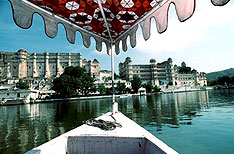 The city of Lakes
The city of Lakes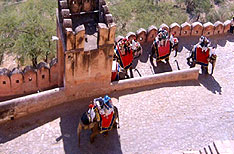 The picturesque capital of Rajasthan, Jaipur is color washed pink-the color associated with hospitality in Rajput culture. This Beautiful city along with Agra and Delhi form what is known as the Golden Triangle of Indian tourist circuit. Built in 1727 A.D. by Maharaja Sawai Jai Singh II, Jaipur displays a remarkable harmony and architectural splendor. The ancient heart of the Pink City still beats in its fairy-tale palaces, rugged fortresses perched on barren hills and broad avenues that dot the entire city. The only planned city of its time, Jaipur is encircled by a formidable wall.
The picturesque capital of Rajasthan, Jaipur is color washed pink-the color associated with hospitality in Rajput culture. This Beautiful city along with Agra and Delhi form what is known as the Golden Triangle of Indian tourist circuit. Built in 1727 A.D. by Maharaja Sawai Jai Singh II, Jaipur displays a remarkable harmony and architectural splendor. The ancient heart of the Pink City still beats in its fairy-tale palaces, rugged fortresses perched on barren hills and broad avenues that dot the entire city. The only planned city of its time, Jaipur is encircled by a formidable wall.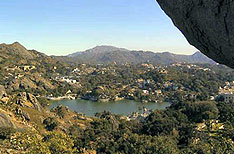 A pleasant retreat set amidst the lush forested hills, Mount Abu is a green oasis in the barren desertscape thats Rajasthan. Situated at the southern tip of the Aravali range the hill retreat owes its cool climate to its rich flora covering the entire hillside that includes coniferous trees and flowering shrubs. The road leading to Mount Abu is a curved one characterized by arid region dotted with huge rocks in weird shapes and high velocity winds. The only hill station in Rajasthan, Mount Abu is more than just a summer retreat. Its stunning array of exquisite Dilwara Jain Temples, dating back 11th- 13th centuries, make it a popular pilgrimage centre. ?Abu? according to a legend.stands for the son of Himalaya, deriving its name from Arbuada,the powerful serpent who rescued Nandi, the sacred bull of Lord Shiva, from a chasm.
A pleasant retreat set amidst the lush forested hills, Mount Abu is a green oasis in the barren desertscape thats Rajasthan. Situated at the southern tip of the Aravali range the hill retreat owes its cool climate to its rich flora covering the entire hillside that includes coniferous trees and flowering shrubs. The road leading to Mount Abu is a curved one characterized by arid region dotted with huge rocks in weird shapes and high velocity winds. The only hill station in Rajasthan, Mount Abu is more than just a summer retreat. Its stunning array of exquisite Dilwara Jain Temples, dating back 11th- 13th centuries, make it a popular pilgrimage centre. ?Abu? according to a legend.stands for the son of Himalaya, deriving its name from Arbuada,the powerful serpent who rescued Nandi, the sacred bull of Lord Shiva, from a chasm.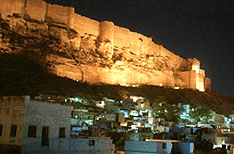 The lifestyle in jodhpur is unusually fascinating with folks wearing lovely multihued costumes,artistically designed. Women folk wear wide gathered skirts and a hip length jacket, with three quarter length sleeves , covering the front and back. The colorful turbans worn by the men folk add more color to the city . It was from here that the popularity worn baggy - tight , horse riding trousers- ? Jodhpurs? took their name.
The lifestyle in jodhpur is unusually fascinating with folks wearing lovely multihued costumes,artistically designed. Women folk wear wide gathered skirts and a hip length jacket, with three quarter length sleeves , covering the front and back. The colorful turbans worn by the men folk add more color to the city . It was from here that the popularity worn baggy - tight , horse riding trousers- ? Jodhpurs? took their name.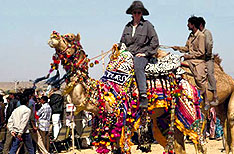 Rising from the heart of the Thar Desert like a golden mirage is the city of Jaisalmer. A commanding fort etched in yellow sandstone stands, with all its awesome splendour, dominating the amber-hued city.
Rising from the heart of the Thar Desert like a golden mirage is the city of Jaisalmer. A commanding fort etched in yellow sandstone stands, with all its awesome splendour, dominating the amber-hued city.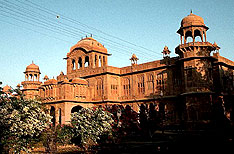 The royal fortified city with a timeless appeal. Lying in the north of the desert state, the city is dotted with many sand dunes. Bikaner retains the medieval splendour that pervades the city's lifestyle. More popularly called the camel country , the city is renowned for the best riding camels in the world. The ship of the desert is an inseparable part of life here. Be it pulling heavy carts , transporting grains or working on wells, camels are the prime helpers.The wells of Bikaner: an important source of water are other attractions of the city. These are built on high plinths with slender minareted towers on each of the four corners and can be noticed even from a distance.
The royal fortified city with a timeless appeal. Lying in the north of the desert state, the city is dotted with many sand dunes. Bikaner retains the medieval splendour that pervades the city's lifestyle. More popularly called the camel country , the city is renowned for the best riding camels in the world. The ship of the desert is an inseparable part of life here. Be it pulling heavy carts , transporting grains or working on wells, camels are the prime helpers.The wells of Bikaner: an important source of water are other attractions of the city. These are built on high plinths with slender minareted towers on each of the four corners and can be noticed even from a distance.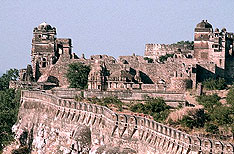 The Pride and glory of Rajasthan, Chittaur echoes with the tales of romance and valour unique to the Rajput tradition. A ruined citadel, where the royal past lives in its imposing forts, graceful palaces and spectacular chattris. This fortified settlement has been ravaged thrice and each time the outcome was 'Jauhar'-when women and children immolated themselves on a huge funeral pyre while men donned in saffron robes of martyrdom rode out of the fort towards a certain death. Alauddin Khilji was the first to sack Chittaur in 1303 A.D. overpowered by a passionate desire to possess the regal beauty, queen Padmini. Legend has it, that he saw her face in the reflection of a mirror and was struck by her mesmerising beauty. But the noble queen preferred death to dishonour and committed 'Jauhar'.
The Pride and glory of Rajasthan, Chittaur echoes with the tales of romance and valour unique to the Rajput tradition. A ruined citadel, where the royal past lives in its imposing forts, graceful palaces and spectacular chattris. This fortified settlement has been ravaged thrice and each time the outcome was 'Jauhar'-when women and children immolated themselves on a huge funeral pyre while men donned in saffron robes of martyrdom rode out of the fort towards a certain death. Alauddin Khilji was the first to sack Chittaur in 1303 A.D. overpowered by a passionate desire to possess the regal beauty, queen Padmini. Legend has it, that he saw her face in the reflection of a mirror and was struck by her mesmerising beauty. But the noble queen preferred death to dishonour and committed 'Jauhar'.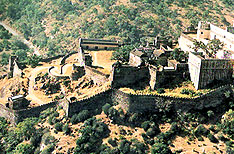 Cradled in the cluster of thirteen mountain peaks of the Aravali ranges,the formidable medieval citadel- Kumbhalgarh stands a wary sentinel to the past glory. Rising from a prominent ridge, 1914 metres high from the sea level, the fort was built in 15th century AD by Maharana Kumbha (1419-63 AD) and is the principal fortification after Chittaurgarh, lying 90 km north-west of Udaipur.
Cradled in the cluster of thirteen mountain peaks of the Aravali ranges,the formidable medieval citadel- Kumbhalgarh stands a wary sentinel to the past glory. Rising from a prominent ridge, 1914 metres high from the sea level, the fort was built in 15th century AD by Maharana Kumbha (1419-63 AD) and is the principal fortification after Chittaurgarh, lying 90 km north-west of Udaipur.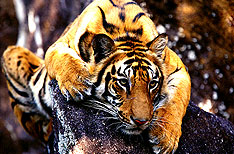 Lying on the main Delhi-Mumbai railway line, Sawai Madhopur is the gateway to the world renowned Ranthambhor National Park- the famous Tiger Reserve , just 12 km away from here. Ranthambhor has been a witness to the rise and fall of many rulers and a series of battle scenes. In the 13th century A.D. Govinda, the grandson of Prithviraj Chauhan took over the reign of the land. Later his successor Vagabhatta, beautified the city and built a noteworthy temple at Jhain.In the middle of the 15th century A.D. Rana Kumbha captured the fort and gifted it to his son to be occupied later by the Hada Rajputs of Bundi and Mughal Emperors Akbar and Aurangazeb. Mughal Emperor Shah Alam gifted it to Maharaja Sawai Madho Singh I of Jaipur in 1754 and since then it was maintained as the hunting preserve of the Maharaja. Queen Elizabeth II and the Duke of Edinburgh were part of the royal hunting who stayed here.
Lying on the main Delhi-Mumbai railway line, Sawai Madhopur is the gateway to the world renowned Ranthambhor National Park- the famous Tiger Reserve , just 12 km away from here. Ranthambhor has been a witness to the rise and fall of many rulers and a series of battle scenes. In the 13th century A.D. Govinda, the grandson of Prithviraj Chauhan took over the reign of the land. Later his successor Vagabhatta, beautified the city and built a noteworthy temple at Jhain.In the middle of the 15th century A.D. Rana Kumbha captured the fort and gifted it to his son to be occupied later by the Hada Rajputs of Bundi and Mughal Emperors Akbar and Aurangazeb. Mughal Emperor Shah Alam gifted it to Maharaja Sawai Madho Singh I of Jaipur in 1754 and since then it was maintained as the hunting preserve of the Maharaja. Queen Elizabeth II and the Duke of Edinburgh were part of the royal hunting who stayed here.